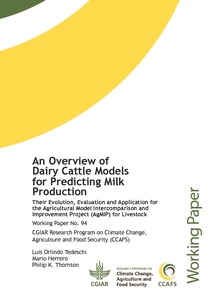Resource information
The contemporary concern about anthropogenic release of greenhouse gas (GHG) into the
environment and the contribution of livestock to this phenomenon have sparked animal
scientists’ interest in predicting methane (CH4) emissions by ruminants. Focusing on milk
production, we address six basic nutrition models or feeding standards (mostly empirical
systems) and five complex nutrition models (mostly mechanistic systems), describe their key
characteristics, and highlight their similarities and differences. Four models were selected to
predict milk production in lactating dairy cows, and the adequacy of their predictions was
measured against the observed milk production from a database that was compiled from 37
published studies from six regions of the world, totalling 173 data points. We concluded that
not all models were suitable for predicting predict milk production and that simpler systems
might be more resilient to variations in studies and production conditions around the world.
Improving the predictability of milk production by mathematical nutrition models is a
prerequisite to further development of systems that can effectively and correctly estimate the
contribution of ruminants to GHG emissions and their true share of the global warming event


